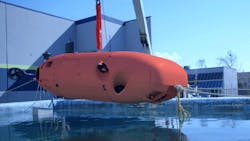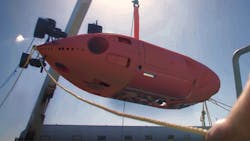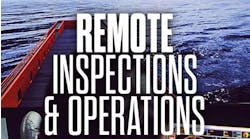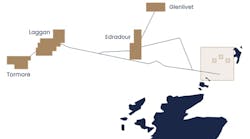OTC 2023: Nauticus Robotics embracing ocean decarbonization
By Ariana Hurtado, Editor and Director of Special Reports
HOUSTON — Nauticus Robotics, a developer of autonomous robots using artificial intelligence (AI) for data collection and intervention services for the ocean industries, showcased its robotics technologies at this year’s Offshore Technology Conference (OTC).
Nauticus recently announced the commissioning of its second-generation Aquanaut, a fully electric, untethered and autonomous subsea robot that is controlled through acoustic communication networking and supported by the company’s toolKITT software. The surface aspect of the Nauticus Fleet is Hydronaut, an 18-m optionally crewed autonomous surface vessel that supports the launch, recovery and real-time operations of Aquanaut.
CTO Dr. John (JD) Yamokoski recently shared his insights with Offshore, detailing the company's latest robotics advancements.
"Nauticus is on a mission to create a future where more autonomous and intelligent robots, like its flagship robot Aquanaut, are used to significantly reduce environmental impact and human exposure to hazards," he said. "Nauticus wants to revolutionize the way in which services are performed in the ocean and lead the industry’s transformation to an economically efficient and environmentally sustainable model. The services Nauticus offers result in not only meaningful cost and safety improvements but also significant carbon footprint reductions."
Not all ROVs are created the same, and Yamokoski explained how other technologies have failed to meet the needs of the offshore industry.
"Operating legacy ROV technology is time-consuming and therefore extraordinarily expensive, with the tether being a major impediment," Yamokoski said. "The manufacturers and industries that use it cannot cut the cord because they have not invested the last 20 years in robotics and autonomy research."
Incumbent methods can cost up to $100,000 per day to operate while emitting significant amounts of CO2 (up to 70 metrics tons, or the equivalent of 5,000 cars on the road at once), he explained.
"These legacy systems require large human crews, posing an inherent safety risk to staff," he said. "Nauticus’ approach leverages advances in AI to deliver more capable systems that require less human intervention thereby reducing the onsite workforce. Longer term, optionally crewed vessels like Hydronaut will become uncrewed and operated from shore, reducing the offshore human footprint for typical inspection and maintenance tasks to zero."
Decarbonization efforts
The company is working toward achieving its net-zero goals through the embrace of ocean decarbonization.
Yamokoski said Hydronaut was built with sustainability in mind. Its compact structure enables it to use 0.5m3 of diesel fuel per day, and Aquanaut is powered 100% electrically using lithium-ion batteries. Current company estimates reflect that the application of this technology will reduce the CO2 footprint of offshore vessels used in this space by more than 90%, reduce the need for people offshore by over 95% and lower value stream costs by 50%, he added.
Development process
Nauticus was formed by a group of robotics engineers that left NASA "determined to disrupt legacy subsea services through robotics technology," Yamokoski said. After field trials and iterations, Nauticus designed and developed an "untethered robot capable of autonomously commuting to a worksite and transforming to complete real work, with minimal operator input required."
The Aquanaut robot has several capabilities and applications due to its versatility and sustainability.
"It transforms from a sleek, hydrodynamic form able to transit long distances to a hoverable manipulation platform with a head, two arms and hands that it can use to perceive and interact with the environment," he explained. "It is the only robot in the world with the ability to nimbly adapt its hydrodynamic and buoyancy profiles while remaining stable to perform sophisticated maneuvering techniques."
Case study
"The assessment of corrosion control measures on subsea assets is a great use case for Nauticus' Aquanaut platform," Yamokoski said. "Assessment can include the visual inspection of common corrosion control systems such as sacrificial anodes. The gold standard for cathodic protection assessment, however, requires the measurement of the electrical potential of the protected structure to a reference electrode. This measurement requires cleaning the measurement site to remove sea growth and then touching a probe to the prepared surface.
Legacy ROV technology provides this in-situ measurement service today, he added, but the same quality measurement can be delivered by the Aquanaut platform with reduced costs and environmental impact.
Tech updates
Looking ahead, Yamokoski said the company plans additional development work on the technology, which he says could have even more offshore applications.
"An untethered platform capable of reaching out and affecting change in the environment has applications spanning from traditional inspection, maintenance and repair to burgeoning markets such as aquaculture," he said. "Nauticus' robotic platforms as well as its vehicle control software, toolKITT, has also gotten the attention of other non-commercial organizations who have strong interests subsea applications."
Future of the offshore energy industry
Yamokoski said the path forward for the offshore energy industry is greater adoption of sustainable subsea technology.
"In April of 2022, Nauticus commenced production of the first of a kind, Nauticus Fleet, a robotic navy of Hydronaut and Aquanaut pairs, which will be deployed to multiple operational bases around the world to service offshore industries ranging from subsea data collection to maintenance and intervention," he explained. "The Fleet was developed to significantly reduce the greenhouse-gas emissions associated with the legacy methods which on the aggregate can be the equivalent of millions of cars per year of effective emissions.
Hydronaut is a small, surface-level vessel that can be operated remotely and autonomously to deploy Aquanaut, a fully electric subsea robot that can repair ocean pipelines, tend to aquaculture and explore seabeds, all without posing any risk to human life.
"It is a real-life transformer functioning as a remotely operated vehicle (ROV) and autonomous underwater vehicle (AUV), seamlessly transitioning between the two," he added. "This novel approach is the culmination of years of research and development and 10s of millions of dollars that Nauticus has invested to prioritize ocean safety and conservation."
05.05.2023







